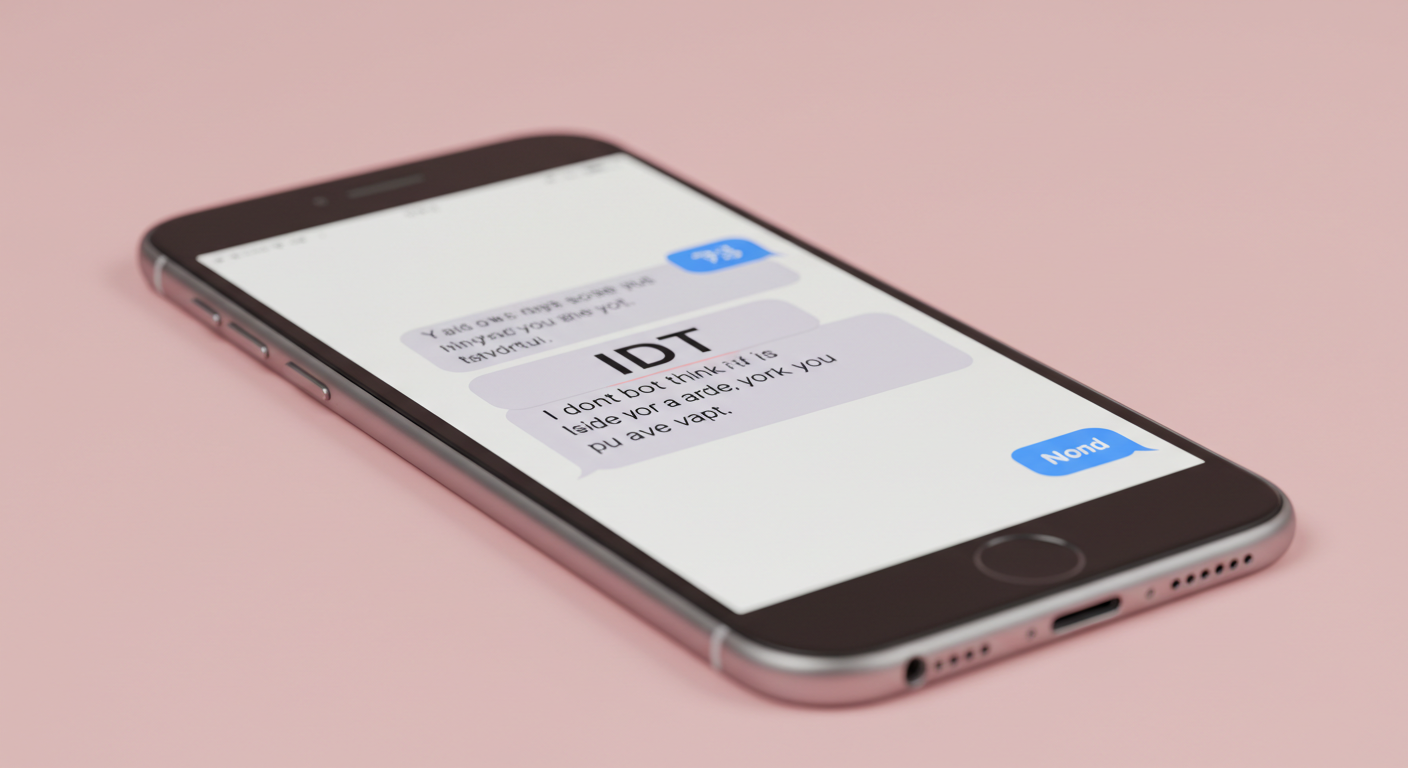When you peek into the kaleidoscope of digital chatter, where every blink of a notification is like a tiny pulse of connection, you’ll find a treasure trove of acronyms, abbreviations, and slang.
Among these, IDT stands as a subtle yet powerful signpost in the wild, fast-paced jungle of online communication.
But what exactly does IDT mean? Why has it wormed its way into our daily convos, and how does it shape the way we express doubt, disagreement, or just casual musings on social media platforms or instant messaging?
Strap in, cause we’re diving deep into the IDT abbreviation universe, breaking it down in a way that’s anything but ordinary.
A Little Backstory on Digital Lingo: The Rise of Acronyms
Before we unravel the IDT full form and all its quirky shades, it’s worth taking a teeny detour through the evolution of digital language.
From the days of Instant messaging platforms like AIM and MSN Messenger—remember those?—to today’s roaring kingdoms of Discord, Twitch, and of course the reigning monarchs Twitter, Instagram, and TikTok, texting slang has been the heartbeat of casual conversations everywhere.
Acronyms aren’t just about saving typing time; they create a kind of shorthand intimacy, a secret code for those who hang out in these online communities.
Some of the most famous acronyms—IDK (I don’t know), IMO (in my opinion), TBH (to be honest)—you’ve probably used or seen without blinking twice.
And IDT, though less flashy, carries its own special weight in expressing uncertainty or skepticism, particularly in the nuanced tone of chat slang.
What Does IDT Mean? The Simple Definition and Common Usage
At its core, IDT stands for “I don’t think.” Yep, straightforward but with plenty of flair hiding underneath. It’s often used to gently express doubt or disagreement without sounding too confrontational or direct.
For example, if someone texts, “This new movie is the best ever,” you might reply, “IDT, it was kinda boring.” It’s a soft way of saying, “I disagree, but I’m chill about it.”
The thing is, this texting abbreviation slips seamlessly between informal communication and even some professional settings, though the latter requires a bit more caution.
It’s casual, but still polite enough to not ruffle feathers in an email or quick Slack message—provided the context’s right. It’s a neat tool in the toolkit of digital language for nuanced conversations.
IDT in Different Contexts: From Casual Chats to Professional Emails
Understanding the tone and context of IDT usage is key to mastering it. In casual texting phrases, it’s a versatile weapon:
- Among friends on social media platforms or instant messaging platforms, it’s a way to express a personal opinion with a light touch.
- In online chat terminology on gaming servers like Discord or Twitch, it can be part of quick-fire exchanges, often paired with other acronyms like IDC (I don’t care) or JSP (just saying please), creating a fast and funny rhythm to the convo.
- In professional email etiquette, slipping an IDT into a message might be risky, unless the relationship is very informal or the team has a relaxed communication style. Even then, spelling it out or choosing more formal language is usually better to avoid misunderstandings.
Misconceptions and Regional Variations: What IDT Is Not
Sometimes people mistake IDT for “I didn’t think,” which can lead to funny or confusing misreads. This highlights how important it is to grasp tone and context in communication. Text can lack the vocal cues we rely on in face-to-face chats, so sarcasm in text or subtle doubts might slip by unnoticed. In Spanish-speaking countries, for instance, you might hear people say “No creo,” which aligns closely with IDT in meaning but sounds completely different—and it’s a great reminder of how language and slang evolve differently around the world.
The Family of Related Acronyms: IDT and Its Chatty Cousins
In the world of popular texting abbreviations, IDT is often seen hanging out with pals like:
- IDK (I don’t know)
- IDC (I don’t care)
- IMO (In my opinion)
- TBH (To be honest)
- TBF (To be fair)
- JSP (Just saying please)
- LMY (Let me you…)
Each of these has its own flavor and place in online chat terms, helping users express nuances from doubt to opinion, caring to indifference, and even polite suggestions.
IDT Explained Through Examples: How to Use It Like a Pro
Here are some ways you might see or use IDT in your daily digital dialogues:
- “IDT that’s the best solution, maybe try something else?”
- “She’s great, but IDT she’s ready for this challenge.”
- “IDT we’ll get tickets, they sold out super fast.”
- “Honestly, IDT this is a good idea but I’m open to hearing more.”
- “IDT you need to worry about that so much, it’s probably fine.”
These examples highlight how IDT gently nudges a conversation into a space of questioning or polite disagreement, perfect for those who want to express doubts without stepping on toes.
The Role of IDT in Social Media and Gaming Communities
On social media posts or during chat conversations in gaming, IDT can be a quick way to voice skepticism or moderate enthusiasm. Picture a Twitch stream where the chat is hyped about an update, but you’re not convinced: dropping an “IDT this patch fixes the bugs” keeps it cool but real. It’s part of the larger digital language evolution, where slang morphs to fit fast-moving environments.
Formal vs. Informal: When to Use IDT and When to Skip It
While IDT fits beautifully into informal communication, it’s best avoided in ultra-formal contexts—think job interviews, legal correspondence, or academic writing. Here, spelling things out fully or opting for more formal phrasing helps maintain professionalism. But in everyday life? It’s a gem.
Alternative Phrases and Synonyms for IDT
If you’re itching for some variation, here are some alternative ways to express the same vibe as IDT:
- “I’m not sure about that.”
- “I doubt it.”
- “Doesn’t seem right to me.”
- “I’m skeptical.”
- “I’m not convinced.”
- “That’s not how I see it.”
- “I beg to differ.”
- “Not really my take on it.”
Using these can add color to your digital convos without relying solely on acronyms.
How to Write Your Own IDT Messages and Make Them Pop
Making your IDT messages more personal or impactful is an art. Here’s a few tips:
- Combine IDT with a reason or explanation: “IDT that’s true because…”
- Pair it with emojis to soften or sharpen the tone, e.g., “IDT 🤔”
- Use it in questions to invite dialogue: “IDT this will work, what do u think?”
- Adapt the style depending on the platform—short and punchy on Twitter, more conversational on WhatsApp.
- Remember your audience and adjust formality accordingly.
Real-Life Anecdotes: IDT in Action Around the World
A friend of mine, an avid gamer from Spain, shared how they switch between “No creo” and IDT depending on whether they’re chatting in English or Spanish. It’s fascinating how these phrases, though linguistically different, perform the same social function—expressing doubt politely. In English-speaking countries, the use of IDT has exploded with platforms like Discord and Twitch, where fast, witty exchanges reign supreme.
Parents in professional settings often joke about how the “younger generation’s acronyms” like IDT infiltrate their emails, sometimes making them scratch their heads. But these little slang gems keep online expression of opinions fresh and relatable across ages.
Wrapping It Up
IDT isn’t just a shorthand—it’s a subtle, clever way to voice skepticism and nuance in our fast-paced digital conversations.
Whether you’re on a dating app like Tinder, scrolling through social media posts, or diving into online chat terminology with friends, understanding and using IDT thoughtfully can make your communication sparkle with clarity and personality.
Frequently Asked Questions
What does IDT mean in text
IDT stands for “I Don’t Think” — it’s a quick way to express doubt or disagreement in texting.
IDT meaning in text
In texting, IDT is used to say you’re unsure or don’t agree with something someone said.
IDT slang
As slang, IDT is a casual, shorthand expression often used in chats, social media, and gaming to save time.
IDT meaning texting
When texting, people use IDT instead of writing the full sentence “I don’t think,” especially in informal conversations.











